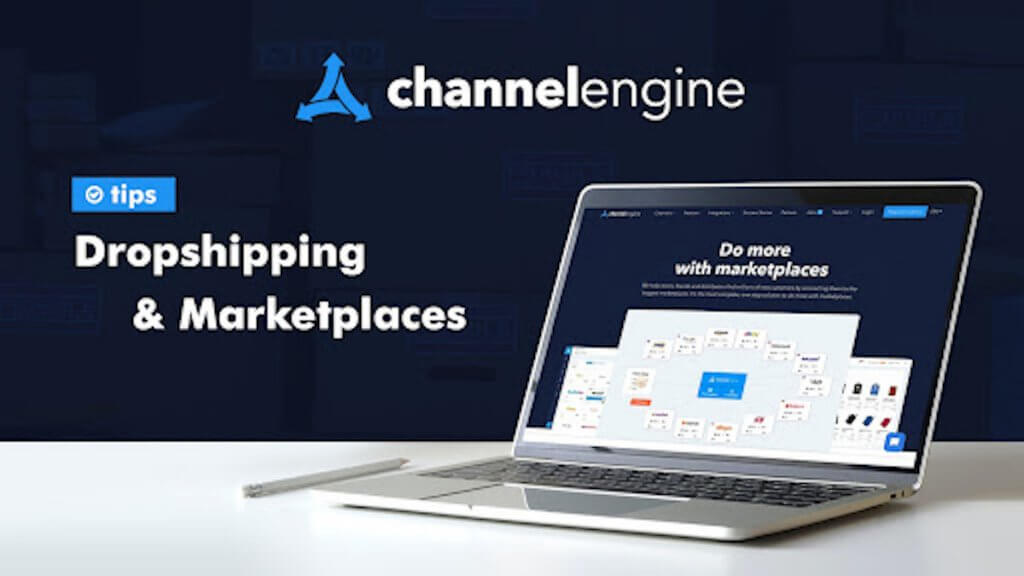How to Perfectly Coordinate Dropshipping & Marketplaces

In this guest post, the marketplace experts from ChannelEngine explore the benefits and challenges of selling drop-shipped items on marketplaces. While the opportunity is huge, the margin for error is tight. Read about some common pitfalls, how to avoid them and some tips that can help you achieve your ambitions.
Maximizing the Potential of Dropshipping via Marketplaces
The dropshipping sales model is one of the most interesting and potentially profitable eCommerce sales-models. If you’re reading this article, the chances are that you are already very aware of the benefits of dropshipping: reduced risk-to-stock, speed, and convenience for the retailer and shopper alike.
Marketplaces are an attractive sales channel for drop-ship sellers as they’re quickly becoming the dominant method for people to buy online. However, the successful marketplace sales of drop-shipped items depends on coordinating the two elements perfectly.
Drop-shipped items are particularly well-suited for marketplaces, especially for those items where inventory storage is an issue or where there is high demand. A close working relationship allows all parties to meet consumer demand. The supplier can ship directly to the consumer. Additionally, the retailer holds its position as the ‘fixer’ who handles the order details and customer service while cutting the profit.
However, the margins for the retailer can be pretty thin, so marketplace sales must run as smoothly as possible. With such tight margins, the best tactic is to aim for high-volume sales with the lowest service burden possible.
The single most important factor for the successful selling of drop-shipped items on marketplaces is the customer experience. This is the one area where the retailer has control. It can affect the enterprise’s profitability in many ways:
- Excessive customer service burden.
- High return rates.
- Shipping errors.
- Negative customer feedback.
All of these potential issues can erode your profit margins until nothing is left. So let’s look at some ways we can reduce this risk and maximize your profits.
Meeting Customer Expectations
Marketplaces feature many diverse sellers with different supply and sales models. Thusly, your drop-shipped items should be marked to avoid confusion. Many potential problems can be avoided if the customer’s expectations are managed. This is achieved with clear communication and accessible information.
You can reduce your customer service burden if you provide answers to typical questions with each order confirmation or email. All of these will help the consumer feel in control of their own order and are more likely to have a satisfactory result.
If a customer needs to contact you, they expect fast response times and the ability to contact you via a range of apps, social media, and messaging services (e.g., Facebook or Telegram). This can all be time-consuming for the seller (and it can present a challenge if you need to check order details or contact the supplier manually). Still, most queries can be handled quickly using smart automation, as we will explore further on.
When It Goes Wrong
Sometimes things will go wrong – hopefully not often – but it does happen.
Ensuring that you can handle this quickly will result in more positive feedback and better margins. Some (supplier-end) common problems that come up with dropshipping include:
- Customer orders out of stock items.
- Fulfillment errors.
- Inability to check actual stock, quality, materials, appearance.
These are hard to solve, but they all have one feature in common – you can avoid them by using only professional and trustworthy suppliers and partners.
When working with trusted suppliers, you can also explore integrations (logistics, delivery info, product content) that make your customer service more accessible and pleasant. All of these will enhance the richness of your communications, and this will result in better customer feedback.
How to Meet Customer Expectations with Integration & Automation Solutions
Your drop-shipped sales are successful when all goes according to plan. But you need an efficient and effective way to resolve problems if things go wrong.
Recognizing that the margins are tight, you need to provide the most efficient customer service possible. This is best achieved by using smart tools and integrations that automate and streamline as many ‘human tasks’ as possible.
Three areas where you can do this include:
- Supplier integration.
- Marketplace integration / stock and order management.
- Customer Service.
Supplier integration can sometimes require customized software tools. Still, suppliers and logistics providers often provide tools that allow users to manage the same data with simple integrations or software of their choice. This means you can give customers better visibility of their order as it progresses.
A marketplace integration solution like ChannelEngine can save serious time (and money) by consolidating all your marketplace integrations into one easy management tool, so your listing management across all platforms is efficiently controlled with a single dashboard. This also saves the costs associated with content management across multiple platforms and marketplaces.
Customer Service is the number one factor in running a successful drop-shipped sales business. Providing a high level of customer service is essential to avoid negative customer experiences. A proactive approach can reduce the overall customer service burden by providing more information ‘up front.’
To get the edge, you should use an automation solution that can take care of the bulk of your customer service inquiries for you. Using a solution like this has been shown to reduce response times by 83%, which goes a long way to improving the customer experience. A complete solution (like Replyco’s helpdesk software), should offer you all the options you need. Sellers should be able to automate communications based on channel-specific keywords – including commonly-needed information, personalized order data (such as tracking and shipping address), customizable auto-fill tags and email templates that include self-service buyer actions (like changing address or delivery time).
Using a smart helpdesk automation solution like this not only reduces your response time; it will also improve the quality and consistency of your customer service and safeguard your margins via lower costs.
Achieving optimal dropshipping sales on marketplaces relies on good customer service, clear, consistent communication and cost control. Using the right integrations, partners, and tools, you can reach that goal and clear the way for future growth.
Want to discover how ChannelEngine and Replyco partner together to help sellers automate and level-up everything from order management to customer support? You can learn more here and here.




